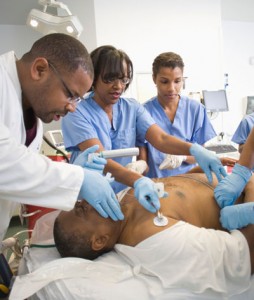 The University of Maryland Medical System, which receives 58 percent of its revenues from public funding, has a more than $180 million debt due to a complex financial scheme that Robert Chrencik executed when he was CFO, and which continued after he became CEO of the statewide system in 2008, according to research released by the state’s largest healthcare workers union, 1199SEIU United HealthCare Workers East.
The University of Maryland Medical System, which receives 58 percent of its revenues from public funding, has a more than $180 million debt due to a complex financial scheme that Robert Chrencik executed when he was CFO, and which continued after he became CEO of the statewide system in 2008, according to research released by the state’s largest healthcare workers union, 1199SEIU United HealthCare Workers East.
The debt, which has at times ballooned to more than $200 million, is a result of UMMS issuing variable rate debt and interest rate swaps. The value of this debt and swaps is tied to interest rates, which, like the spinning wheels of a slot machine, change frequently. In entering into these agreements, UMMS bet that interest rates will rise but it was a poor bet because interest rates are difficult to predict. This gamble has caused UMMS to pay more in interest than it would have paid absent the interest rate swaps. In addition, to cover the bets, UMMS is forced to post collateral. Thus, financial resources that could be used for patient care are instead being used to service this debt.
“Executives at the University of Maryland Medical System are gambling with patient care dollars, resulting in debt—and now they are laying off workers while still paying themselves millions each year,” said John Reid, executive vice president for the Maryland/DC region of the Union, which is launching, in conjunction with release of the research, a corporate information campaign with billboard, radio, newspaper and online advertisements. “The people of Maryland deserve better use of our patient care resources. UMMS receives the majority of its funding from our tax dollars.”
The fact that the University of Maryland Medical System, with twelve hospitals throughout the State, receives a majority of its funding from the public raises other important issues about whether UMMS should be engaging in risky financial transactions:
—The Potential Misuse of Charitable Assets. UMMS is both an instrumentality of the State and a registered 501c3. In addition to receiving a majority of its revenues from public funding, it solicits and collects donations. We believe that their unique position warrants a more conservative financial stewardship.
–Proper Exercise of Fiduciary Duty by UMMS Executives Executives who run charities have a heightened responsibility to ensure that monies entrusted to them are used in a conservative and appropriate manner. Compared to the other large hospital systems in Maryland, we believe UMMS took more ill-advised risks that have turned out poorly.
 —The Use and Exposure of Taxpayer Funds in Risky Interest Rate Swaps Unlike the other large hospital systems in Maryland, UMMS receives more state funding and is governed by the State. Also, due to its aggressive growth plans that are state-financed, Marylanders have an additional incentive to make sure that the healthcare system is being prudent with funds, especially as the Affordable Care Act is implemented. Both the State and its taxpayers are potentially on the hook for any losses resulting from the System’s variable rate debt and interest rate swaps.
—The Use and Exposure of Taxpayer Funds in Risky Interest Rate Swaps Unlike the other large hospital systems in Maryland, UMMS receives more state funding and is governed by the State. Also, due to its aggressive growth plans that are state-financed, Marylanders have an additional incentive to make sure that the healthcare system is being prudent with funds, especially as the Affordable Care Act is implemented. Both the State and its taxpayers are potentially on the hook for any losses resulting from the System’s variable rate debt and interest rate swaps.
While other large hospital systems in Maryland participated in these risky financial gambles during the economic collapse of 2008 and 2009, UMMS—which was in poorer financial health and, at times, has had a larger share of these bets—was impacted to a higher degree than its competitors by their use.
1199SEIU United Healthcare Workers East is the largest and fastest-growing healthcare union in Maryland and the nation. We represent 400,000 members throughout Massachusetts, New York, New Jersey, Maryland, Washington, D.C. and Florida, with nearly 10,000 members in Maryland. Our mission is to achieve quality care and good jobs for all.
Click here to tell your story about financial mismanagement.




